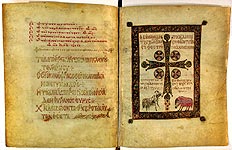Tetraevangelion.
11th cent. (first third). Constantinople
Q (215 ű 170). 259 leaves.
Parchment, paper (leaves 1-10). Ink, colours, gold.
It is written in a minuscule hand.
There are 3 portraits of the Evangelist (fols. 21v, 88v, 204v), 7 multicolour ornamental head-pieces and initials with gold, 3 frames, 10 frames specifically for the Canon Tables. Folio 14 includes the depiction of the four-point cross with the goat and the pig at the basis; the cross and its frame are cloaked in the ornamental pattern in the style, reminiscent of cloisonne enamel. The text on folios 14v-15r are also framed with the ornament of petals, reminiscent of cloisonne enamel.
The ornamental design of the Tetraevangelion (Four Gospels) follows the course of artistic tendencies of Byzantine book-painting from the first third of the 11th century. The ornamental frames for the Canon Tables, head-pieces and initials are among elements of manuscripts, wide-spread after the turn of centuries. The style of writing known as "pearl minuscule script" is also typical of that time. During the restoration of the manuscript in 1977-1979, there was made up a conclusion that three portraits of the Evangelist had been added at a later date.
In 1851 the manuscript was donated to the Imperial Public Library by Sandrini, the consul of the Syros Island.
Shelfmark: –ÕŃ, √ūŚų. 67.





